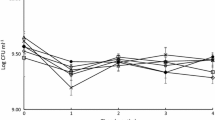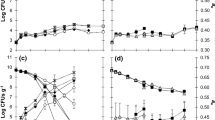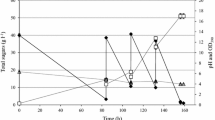Abstract
The biocontrol yeast Pichia anomala J121 can effectively reduce mould growth on moist cereal grains during airtight storage. Practical use of microorganisms requires formulated products that meet a number of criteria. In this study we compared different formulations of P. anomala. The best way to formulate P. anomala was freeze-drying. The initial viability was as high as 80%, with trehalose previously added to the yeast. Freeze-dried products could be stored at temperatures as high as 30 °C for a year, with only a minor decrease in viability. Vacuum-drying also resulted in products with high storage potential, but the products were not as easily rehydrated as freeze-dried samples. Upon desiccating the cells using fluidised-bed drying or as liquid formulations, a storage temperature of 10 °C was required to maintain viability. Dependent on the type of formulation, harvesting of cells at different nutritional stresses affected the initial viabilities, e.g. the initial viability for fluidised-bed-dried cells was higher when the culture was fed with excess glucose, but for freeze-drying it was superior when cells were harvested after depletion of carbon. Using micro-silos we found that the biocontrol activity remained intact after drying, storage and rehydration for all formulations.




Similar content being viewed by others
References
Abadias M, Benabarre A, Teixido N, Usall J, Vinas I (2001a) Effect of freeze drying and protectants on viability of the biocontrol yeast Candida sake. Int J Food Microbiol 65:173–182
Abadias M, Teixido N, Usall J, Benabarre A, Vinas I (2001b) Viability, efficacy, and storage stability of freeze-dried biocontrol agent Candida sake using different protective and rehydration media. J Food Prot 64:856–861
Abreu J, Gonzalez J, Jaqueman F (2003) Concervation por liofilizacion de diferentes especies de generos de levaduras. Alimentaria 343:119–122
Acker JP, Lu XM, Young V, Cheley S, Bayley H, Fowler A, Toner M (2003) Measurement of trehalose loading of mammalian cells porated with a metal-actuated switchable pore. Biotech Bioeng 82:525–532
Bayrock D, Ingledew WM (1997) Mechanism of viability loss during fluidized bed drying of baker’s yeast. Food Res Int 30:417–425
Björnberg A, Schnürer J (1993) Inhibition of the growth of grain-storage molds in vitro by the yeast Pichia anomala (Hansen) Kurtzman. Can J Microbiol 39:623–628
Cerrutti P, de Huergo MS, Galvagno M, Schebor C, Buera MD (2000) Commercial baker’s yeast stability as affected by intracellular content of trehalose, dehydration procedure and the physical properties of external matrices. Appl Microbiol Biotechnol 54:575–580
Crowe JH, Carpenter JF, Crowe LM (1998) The role of vitrification in anhydrobiosis. Annu Rev Physiol 60:73–103
Diniz-Mendes L, Bernardes E, de Araujo PS, Panek AD, Paschoalin V M F (1999) Preservation of frozen yeast cells by trehalose. Biotechnol Bioeng 65:572–578
Druvefors U, Jonsson N, Boysen ME, Schnürer J (2002) Efficacy of the biocontrol yeast Pichia anomala during long-term storage of moist feed grain under different oxygen and carbon dioxide regimens. FEMS Yeast Res 2:389–394
Druvefors UÄ, Mokiou S, Magan N, Hökeberg M, Jonsson N, Schnürer J (2006) Biocontrol potential of dry formulated and freshly harvested Pichia anomala J121 cells during long-term airtight storage of wheat grain. J Appl Microbiol (in press)
Eleutherio ECA, Maia FM, Pereira MD, Degre R, Cameron D, Panek AD (1997) Induction of desiccation tolerance by osmotic treatment in Saccharomyces uvarum var carlsbergensis. Can J Microbiol 43:495–498
Fonseca F, Passot S, Cunin O, Marin M (2004) Collapse temperature of freeze-dried Lactobacillus bulgaricus suspensions and protective media. Biotechnol Prog 20:229–238
Jennings TA (1999) Lyophilization—Introduction and basic principles. CRC, Boca Raton, Florida
Jijakli MH, Lepoivre P (1998) Characterization of an exo-beta-1,3-glucanase produced by Pichia anomala strain K, antagonist of Botrytis cinerea on apples. Phytopathology 88:335–343
Manzanera M, de Castro AG, Tondervik A, Rayner-Brandes M, Strom AR, Tunnacliffe A (2002) Hydroxyectoine is superior to trehalose for anhydrobiotic engineering of Pseudomonas putida KT2440. Appl Environ Microbiol 68:4328–4333
Manzanera M, Vilchez S, Tunnacliffe A (2004) High survival and stability rates of Escherichia coli dried in hydroxyectoine. FEMS Microbiol Lett 233:347–352
Masih EI, Alie I, Paul B (2000) Can the grey mould disease of the grape-vine be controlled by yeast? FEMS Microbiol Lett 189:233–237
Melin P, Håkansson S, Eberhard TH, Schnürer S (2006) Survival of the biocontrol yeast Pichia anomala after long-term storage in liquid formulations and different temperatures, assessed by flow cytometry. J Appl Microbiol 100:264–271
Petersson S, Schnürer J (1995) Biocontrol of mold growth in high-moisture wheat stored under airtight conditions by Pichia anomala, Pichia guilliermondii, and Saccharomyces cerevisiae. Appl Environ Microbiol 61:1027–1032
Roser B, Colaco C (1993) A sweeter way to fresher food. New Sci 138:25–28
Shetaia YM, El-Baz AF (2004) Viability and thermal stability of Pichia anomala freeze-dried in different polymers. Afr J Mycol Biotechnol 12:49–59
Tang XL, Pikal MJ (2004) Design of freeze-drying processes for pharmaceuticals: Practical advice. Pharm Res 21:191–200
Tunnacliffe AG, Welsch DT, Roser BJ, Dhaliwal KS, Colaco C (1998) Methods of preserving prokaryotic cells and compositions obtained thereby. In Patent WO9824882A1
Acknowledgements
Dr Thomas H. Eberhard and Miss Åsa Schoug for technical advice concerning fermentation and freeze-drying and Mrs Elisabeth Börjesson for GC analysis are greatly acknowledged. Cargill Health and Food Technology Europe (Krefeld, Germany) is acknowledged for the generous gift of trehalose. This work was supported by the Swedish Foundation for Strategic Environmental Research (MISTRA) by funding the research programme Domestications of Microorganisms (DOM).
Author information
Authors and Affiliations
Corresponding author
Rights and permissions
About this article
Cite this article
Melin, P., Håkansson, S. & Schnürer, J. Optimisation and comparison of liquid and dry formulations of the biocontrol yeast Pichia anomala J121. Appl Microbiol Biotechnol 73, 1008–1016 (2007). https://doi.org/10.1007/s00253-006-0552-x
Received:
Revised:
Accepted:
Published:
Issue Date:
DOI: https://doi.org/10.1007/s00253-006-0552-x




